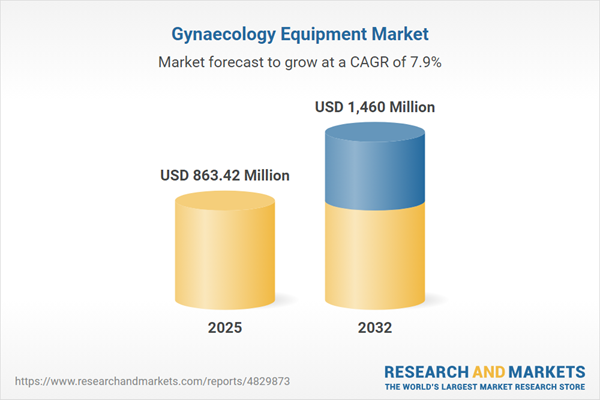Speak directly to the analyst to clarify any post sales queries you may have.
The gynaecology equipment market is experiencing a period of robust transformation as innovation, digital advances, and shifting clinical demands reshape women's healthcare delivery worldwide.
Market Snapshot: Gynaecology Equipment Market Size and Growth
The gynaecology equipment market grew from USD 800.39 million in 2024 to USD 863.42 million in 2025. It is projected to expand at a CAGR of 7.85%, reaching USD 1.46 billion by 2032. Accelerated by rising demand for minimally invasive procedures and broader adoption of digital solutions, the sector continues to track significant growth across all major regions and product categories.
Scope & Segmentation
- Product Types: Electrosurgical devices (monopolar and bipolar), fetal monitoring systems (external and internal, including ultrasound-based and electrode/catheter modalities), fluid management systems (closed and open), hysteroscopes (flexible and rigid), operating tables (manual and motorized), and ultrasound devices (2D, 3D/4D, Doppler – including transabdominal, transvaginal, real-time imaging, volumetric, and color/pulse power Doppler).
- End Users: Ambulatory surgical centers (hospital-affiliated and standalone), clinics (fertility and gynecology), home care, hospitals (private and public), and specialty clinics (obstetrics and reproductive centers).
- Sales Channels: Offline and online procurement platforms.
- Portability: Portable equipment (handheld, trolley-mounted) and stationary equipment (console-based, floor-mounted).
- Regions: Americas (including US, Canada, Mexico, Brazil, Argentina, Chile, Colombia, Peru), Europe, Middle East & Africa (UK, Germany, France, Russia, Italy, Spain, Netherlands, Sweden, Poland, Switzerland, UAE, Saudi Arabia, Qatar, Turkey, Israel, South Africa, Nigeria, Egypt, Kenya), Asia-Pacific (China, India, Japan, Australia, South Korea, Indonesia, Thailand, Malaysia, Singapore, Taiwan).
- Companies Analyzed: GE Healthcare, Siemens Healthineers AG, Koninklijke Philips N.V., Johnson & Johnson, Canon Medical Systems Corporation, Hologic, Inc., Medtronic plc, Olympus Corporation, Boston Scientific Corporation, Becton, Dickinson and Company.
Key Takeaways for Senior Decision-Makers
- Integration of digital health and telemedicine is fundamentally altering procurement and care delivery models, especially as remote monitoring capabilities gain traction.
- Technological innovation, particularly advances in artificial intelligence imaging and electrosurgical systems, is improving diagnostic precision and procedural safety across care settings.
- Flexible hysteroscopic and fluid management platforms are streamlining workflows, enabling less invasive procedures and supporting the shift toward outpatient treatment.
- Evolving regulatory frameworks emphasize ongoing device performance monitoring, prompting manufacturers to accelerate product lifecycles and align with new compliance requirements.
- Strategic partnerships and mergers are expanding competitive portfolios, while service offerings such as training and aftermarket support are increasingly important for customer retention.
- Sustainable manufacturing processes and resilient supply chains are becoming core differentiators as environmental and ethical considerations influence procurement decisions.
Tariff Impact on Supply Chains and Market Dynamics
The United States 2025 tariff schedule has added complexity to global sourcing and procurement for gynaecology equipment. Increased duties on core components have encouraged nearshoring and alternative supplier agreements, with pricing pressure felt across distributors and end users. Market participants are responding by adopting digital procurement tools, reengineering products, and pursuing advocacy efforts to mitigate negative impacts on patient access.
Methodology & Data Sources
This report leverages primary interviews with clinical experts and procurement executives, alongside secondary data from journals, regulatory sources, and industry publications. Multiple data triangulation steps ensure accuracy. Scenario analysis and peer review provide additional validation for emerging trends, company positioning, and technology trajectories.
Why This Report Matters to Senior Decision-Makers
- Enables agile strategy formulation by identifying regional nuances, growth drivers, and evolving adoption patterns within the gynaecology equipment sector.
- Provides actionable insights into how regulatory changes, new technologies, and market shifts can impact investment, procurement, and product development decisions.
- Supports operational optimization through competitive benchmarking, value chain analysis, and assessment of sustainable practices relevant to current stakeholder expectations.
Conclusion
The gynaecology equipment market is poised for continued evolution, driven by digital integration, regulatory shifts, and ongoing technological breakthroughs. Senior stakeholders equipped with these insights are prepared to make informed, future-focused decisions in a dynamic health technology environment.
Additional Product Information:
- Purchase of this report includes 1 year online access with quarterly updates.
- This report can be updated on request. Please contact our Customer Experience team using the Ask a Question widget on our website.
Table of Contents
3. Executive Summary
4. Market Overview
7. Cumulative Impact of Artificial Intelligence 2025
Companies Mentioned
The companies profiled in this Gynaecology Equipment market report include:- GE Healthcare
- Siemens Healthineers AG
- Koninklijke Philips N.V.
- Johnson & Johnson
- Canon Medical Systems Corporation
- Hologic, Inc.
- Medtronic plc
- Olympus Corporation
- Boston Scientific Corporation
- Becton, Dickinson and Company
Table Information
| Report Attribute | Details |
|---|---|
| No. of Pages | 181 |
| Published | October 2025 |
| Forecast Period | 2025 - 2032 |
| Estimated Market Value ( USD | $ 863.42 Million |
| Forecasted Market Value ( USD | $ 1460 Million |
| Compound Annual Growth Rate | 7.8% |
| Regions Covered | Global |
| No. of Companies Mentioned | 11 |









